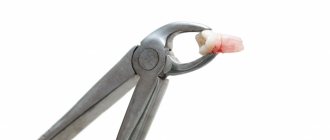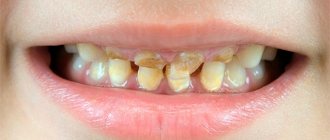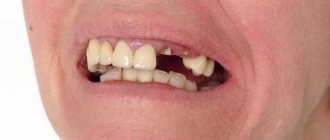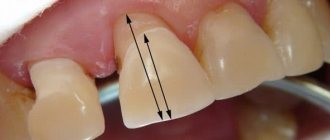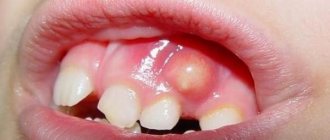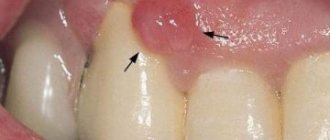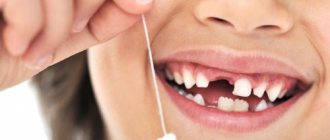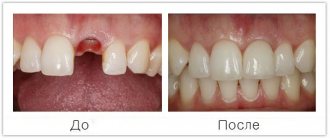When do the first teeth start to fall out?
Children's baby teeth are replaced by permanent incisors and molars. The first tooth falls out at 6-7 years of age, but the timing may vary depending on the development of the jaw apparatus and the health of the child’s oral cavity. Mammary units are formed in the womb, and the permanent bite is formed after the baby is born. The timing of the change will depend on the growth rate of the tooth buds. The sequence of drops is the same for everyone:
- sixth teeth grow (they are not baby teeth);
- the lower and then the upper incisors become loose;
- first and second premolars fall out;
- fangs change;
- Wisdom teeth begin to grow at 10-25 years of age, sometimes remaining impacted.
Children receive a permanent bite by the age of 14. Parents have enough time to decide where to put their lost teeth.
First steps in case of loss
A baby whose milk elements begin to change does not need painkillers. Adults think that the procedure of changing units is extremely unpleasant for the child, but before the tooth begins to loosen, the roots in it dissolve.
Losing teeth can be a shock to little ones, so parents should explain to them that this is normal, and new healthy teeth will soon grow and remain forever. At the age of 7-14 years, the oral cavity needs careful hygiene, and after removal, the following rules must be followed:
- immediately rinse your mouth with soda;
- prohibit the child from touching the wound to avoid infection;
- When the meal is over, rinse your mouth with warm water.
To help with loosening, you can give your child hard fruits and vegetables: apples, pears, carrots. Dried fruits in small quantities are also suitable.
Adviсe
A loose tooth is of considerable interest to a child. The baby just wants to touch it. How should parents behave in such a situation:
- If you notice that your baby's first tooth will soon fall out, be sure to tell him about what is about to happen. Explain that there is nothing wrong with this. A new, stronger tooth will grow in place of the fallen one.
- It is very important to explain to your child that you should not touch your teeth with your hands. Kids do this quite often, especially when their teeth begin to loosen. It's so interesting and incomprehensible. Try to explain clearly that in this way the child can get an infection. You must understand that this can lead to the development of inflammation and cause pain.
- You need to be prepared that when a tooth falls out, blood will begin to ooze. The main thing here is not to panic. Make sure that the baby is not scared. To stop it, you need to give the child a soda solution (a teaspoon per glass of warm water). Let your baby rinse his mouth until the wound stops oozing.
- There is no need to give your child anti-inflammatory medications or analgesics. They are not necessary.
In what cases is a doctor's help required?
There are situations when problems arise with the change of organs in the mouth.
In 80% of children, it is discovered that the permanent molar erupts behind the milk tooth, and this forms an incorrect bite. A temporary formation that does not want to leave its place is removed surgically. This will avoid the growth curve of the root element. Only a dentist will be able to pull out a unit if its root has not resolved, but has grown deeply into the gum. Self-removal can cause severe inflammation of the mucous membrane. In most cases, baby teeth fall out on their own. A child may need specialist help in several atypical situations:
- the gums are swollen and very painful;
- the milk element is broken;
- the wound bleeds for a long time;
- the child swallowed a tooth.
Why don't baby teeth fall out?
There are several reasons for the delayed (late) loss of dentition units:
- hereditary predisposition,
- gender of the child (according to observations, boys are more predisposed to late shifts),
- past metabolic diseases, various serious infections, as well as rickets, phenylketonuria, and dysfunction of the endocrine system (all this has a significant negative impact on the mineral composition, and, consequently, the quality of tooth enamel),
- pathology during pregnancy, which affects the process of formation and quality characteristics of baby teeth;
- quality of food, water and air (including percentage of oxygen);
- the general state of the environment in the place of residence;
- climatic zone (for example, in cold Murmansk, precipitation may occur somewhat later than in the warmer city of Voronezh).
What are the consequences of delayed loss of primary teeth? The main danger is the high probability of developing a malocclusion. If the child is over 8 years old and there are still no signs of loss, a prompt visit to the pediatric dentistry is mandatory.
Customs for the loss of the first milk teeth
Different countries had their own signs and ways of getting rid of the first teeth that fell out. The majority performed the ritual with all the dental units that left the baby at the age of 6-14:
- in England, parents resorted to burning teeth so that magicians would not use them for their witchcraft purposes;
- in Rus', children turned to the brownie and the mouse, throwing a tooth behind their back and asking them to bring a “bone” tooth instead of a “burdock” one;
- the Romals made a conspiracy for wealth and long life for the baby by throwing a tooth to the moon;
- In Asian countries, the top tooth that fell out was thrown onto the roof, and the bottom one was placed under the floor.
Common Beliefs
Signs came from antiquity, and almost all nations have them.
It is believed that if a tooth is lost or thrown away, this promises the child an early departure from the parents’ home or life outside the homeland. In England they believed that a tooth not set on fire prophesies the appearance of dog fangs in a baby. In Rus', a child had to “give his milk tooth to the mouse”, replacing it with a new one. Mothers believed that this also accelerates the growth of other indigenous elements. In some European countries, it was long believed that after death the soul cannot rest until it finds its milk teeth. Their parents prudently burned them so that they would wait for their owner in the next world. This ritual also protected children from the evil eye and bad thoughts.
There are other folk beliefs regarding the teeth of both adults and children. The signs about wisdom teeth, which have always been attributed with unique properties, deserve special attention: if they are present, good luck will not leave a person, wealth and achievement of heights in career and love await him. The owner of a smile with 32 “pearls” could count on the help of his ancestors - they would never leave a relative, providing support in any matter. Previously, the question of why wisdom teeth grow had a simple answer - a person uses 100% of his mental abilities. The presence of all four "wise" units was considered a sign of a strong spirit. Some defects also spoke volumes:
Read also: The child grows a second row of teeth
- If a tooth chipped or broke, it was considered a bad sign. The person was damaged, the evil eye was cast upon him, and illness was expected.
- Diastema (gap) between the front teeth. Tibetan medicine attributed this feature to the presence of enormous energy potential in humans.
- A lost wisdom tooth in an adult was considered a sign of the imminent loss of a close relative. When asked why he was in pain, there was another explanation - the person would be faced with a difficult choice.
Where should I put the tooth and can it be stored?
Many mothers are sentimental about such things, putting the first ultrasound picture, a tag from the maternity hospital, or a lock of hair in a box. If a tooth has left its owner, parents often do not know what to do with it. Just throwing it away is too simple and at the same time difficult, because changing the first tooth is a whole event. The items that fall out are most often placed under the pillow, and when the child falls asleep, they are replaced with a small gift, candy. Although this is not very convenient, since the baby can push the tooth into the corner of the bed, and it will be difficult to find it.
Myths about the tooth fairy
The tooth fairy, invented by the writer Luis Coloma, has deeply entered the culture of Western countries and solved the question of parents about where to put their child’s teeth. Children like the deal with the fairy - it is entertaining and rewarding. Before going to bed, the child needs to put the fallen tooth under the pillow, and in the morning a gift or coin will appear in the bed instead. Parents, of course, must remember to make the substitution.
The myth of the tooth fairy is a useful one: it helps in overcoming the fear of a lost tooth, the child receives compensation for the pain experienced. Writer Vicky Lansky advises parents to tell their children that the fairy brings more gifts for a healthy tooth than for a damaged one. This motivates kids to maintain hygiene.
Don't panic! A child’s baby tooth falls out, but the root remains - what to do?
All parents sooner or later enter an unpleasant period associated with the beginning of the replacement of their child’s baby teeth with permanent ones. Such changes bring a lot of worry to moms and dads, because most often tooth loss occurs at home and there is always concern that root particles may remain in the socket.
To avoid undesirable consequences, parents are advised to familiarize themselves with all the necessary information long before the first baby tooth falls out.
Possible reasons why a child’s baby tooth has fallen out
The main reason for the loss of baby teeth is the eruption of permanent teeth. The process of replacing baby teeth is preceded by the resorption of their roots. After root loss, the baby tooth becomes loose and falls out. Most often, the process does not cause the child significant discomfort or pain, and the vacated space is subsequently filled with the erupting permanent incisor.
Replacing a baby tooth with a permanent one
Attention! The replacement of baby teeth with permanent ones is a natural process established by nature. Root teeth are stronger and more resilient, they are distinguished by the hardness and density of the enamel, therefore making it easier for the child to adapt to adult food.
The first loss of baby teeth occurs after the child reaches the age of six, which is considered the norm in dentistry. It takes 6 to 8 years for permanent teeth to form.
This is exactly how long it will take for 20 baby teeth to fall out and 32 root teeth to erupt. But due to the individual characteristics of each individual child’s body, minor deviations from the established schedule are allowed.
However, if your first baby tooth falls out at age 4 or even at age 5, you should consult a specialist , as this may be due to improper oral care. Early loss of baby teeth, as well as delays in the schedule, is fraught with serious defects in the developing dentition, and therefore requires supervision by a pediatric dentist.
How to understand that a child’s tooth extraction was successful
We focus on the fact that it is necessary to accustom your child to visiting the dentist from an early age; this must be done as the primary occlusion develops, i.e. starting from 2 years. Frequency – 3-4 times a year. This way, it will be possible to avoid many problems associated with dental diseases or stop them at an early stage of development. If a tooth has to be removed for reasons unrelated to disease (supernumerary teeth, early eruption of permanent teeth), then the child will not panic from going to the doctor - for him this will be a completely natural phenomenon.
After tooth extraction, you should not be alarmed by symptoms such as slight swelling and blue discoloration of the gums (this goes away within a day at most), pain, numbness of the jaw and lower part of the face, slight bleeding, pain when opening the jaws. All these are normal post-operative consequences that you just need to endure. Some of them will go away on their own in a couple of days, others in a maximum of a week.
Child after tooth extraction
What does a lost baby tooth look like (photos below)?
Many parents, out of ignorance, tend to think that baby teeth do not have roots at all. At the same time, some mothers and fathers are horrified when a developed root system is not found on a lost baby tooth, believing that part of the tooth remains in the child’s gum. Brief information about what a lost baby tooth looks like will help dispel all the myths. A photo of the removed bone formation will provide the best idea of it.
Temporary incisors are identical to permanent incisors in structure, but differ in smaller crown sizes, thinner enamel and the presence of rather wide canals and large pulp. Despite numerous misconceptions, the root system of a baby tooth is present and ensures the proper performance of the functions of grinding food and forming a normal bite.
Pulled out milk tooth with root
The absence of roots in a fallen baby tooth is explained by their resorption at a certain stage of a person’s life to allow permanent bone structures to erupt, which is the norm.
What should you eat and drink after tooth extraction?
On the day of extraction, you should not eat anything dense or hard; you should chew on the healthy side of the jaw to reduce the risk of additional injury to the wound surface. It is better to snack on something soft or something that you can swallow without chewing, for example, mashed potatoes or broth. All foods should be moderately warm (about 36°C), as hot food increases blood circulation and can cause bleeding.
Rules for drinking drinks
All drinks should be consumed only from a mug or glass without the help of straws, since pressure changes in the oral cavity will negatively affect the healing of the hole. After tooth extraction, you should drink liquid in small sips so as not to provoke the expulsion of a blood clot from the socket and the development of “dry socket” syndrome.
Prohibited drinks
In the first postoperative days, any drinks that irritate the mucous membrane are prohibited:
- berry and fruit juices;
- lemonades, fruit drinks;
- sparkling water;
- strong coffee.
Allowed and healthy drinks
It is better to replace coffee and juices with herbal infusion (chamomile or linden), rosehip decoction and dried fruit compote without sugar. Such drinks not only quench thirst, but also remove inflammation.
After tooth extraction, you can drink plain water as much as you want, since water will not harm the healing process. Regular chilled black tea is also useful, as it promotes wound healing due to its tannic acid content. If there is bleeding after tooth extraction, you can not drink the drink, but put a tea bag on the gum. This can be done 3 hours after surgery.
Read also: How to stop bleeding in the mouth
Diet after tooth extraction
On the first day after tooth extraction, food should be of a uniform consistency, easy to chew and swallow. The temperature regime should be observed: you should not eat too hot or cold food. It is advisable to warm food from the refrigerator to room temperature.
On the second day, the diet expands.
To purees and porridges you can add pasta, steamed cutlets, stewed vegetables and soft twisted meat prepared using gentle mechanical and thermal processing methods. You cannot completely give up meat products; nutrition after tooth extraction should be balanced and rich in proteins , since they are necessary for the regeneration of soft tissues.
At first, it is better to avoid salty and spicy foods, and in no case should you eat crackers, nuts and other foods that can injure your gums. The same rule applies to tough vegetables and fruits.
3–4 days after tooth extraction, you can already drink weak coffee, but no more than one cup per day.
After tooth extraction, it is better to eat in small portions, maybe every hour or whenever you want to eat, but little by little. This will promote uniform distribution of the load on the wound surface and healing of the hole. After each meal, you need to drink some water or unsweetened tea to wash away any remaining food from the socket, since rinsing the mouth in the first few days after vomiting is prohibited.
Tooth enamel and gums must be cleaned with extreme caution, using a soft brush and without touching the wound surface. Especially if a wisdom tooth removal procedure was performed. Chewing gum, sucking lollipops and breath fresheners are prohibited because they contain a lot of harmful substances that can negatively affect tissue regeneration.
Sample menu
For breakfast in the first days after tooth extraction you can eat:
- pureed cottage cheese with a little added sugar;
- thick yogurt;
- pudding;
- chilled steam omelette;
- oatmeal, pearl barley and other grain porridges.
Suitable for lunch:
- pureed pea soup;
- cream of mushroom soup;
- mashed potatoes;
- steamed vegetables.
Dinner can be presented:
- a glass of kefir, warm milk or yogurt;
- tender casserole;
- whipped curd dessert without added sugar;
- mashed potatoes.
More accurate information about how you can eat after tooth extraction should be obtained from the dentist, and sometimes from the therapist: if there are any physiological characteristics or chronic diseases.
Eating sweets
It is better to exclude sweets, cookies and waffles from the menu for several weeks after a person has had a tooth pulled out. If you want something sweet, you can eat store-bought or homemade children's fruit purees, marshmallows and curd desserts.
What to do if the root of a baby tooth remains in the gum?
A situation where a child’s baby tooth falls out, but the root remains, can drive all parents into hysterics. In fact, in most cases, the fears of mothers and fathers are not confirmed, and the visible particle in the resulting wound turns out to be only the tip of an erupting permanent tooth.
Read also: At what age do children’s teeth change?
However, particles of primary incisors also often remain in the gums , which is explained by the fragility of temporary bone formations. But it must be taken into account that such situations only happen when a baby tooth is removed prematurely, the roots of which have not yet had time to dissolve, or as a result of injury.
Important! If the first baby tooth has fallen out, which by that time was already loose, there is no reason to worry, because the remaining fragment is an erupting root tooth. Otherwise, and to reassure parents, it is better to contact a pediatric dentist, who will prescribe an X-ray examination and be able to determine the nature of the visible bone structure.
On the Internet you can find many recommendations regarding the situation when the root of a baby tooth remains in the gum. If the destruction of a baby tooth occurs due to injury and the remaining part is the root system, you can carefully take the fragment and check whether it is loose.
Baby tooth fell out without root
It is not difficult to remove a loose root of a baby tooth, but it is important to ensure that the procedure is sterile. If the root sits firmly in the gum, you need to exclude any third-party influence on it, including eating solid food, and immediately visit a pediatric dentist.
Features of caring for a place with a fallen milk tooth
Immediately after the loss, a dimple appears in the place of the lost unit of the dentition, in which bleeding can be observed. In such a situation, you need to perform the following simple procedures:
- rinsing your mouth with an antiseptic,
- checking the formed hole for the presence of remains of the roots of a baby tooth,
- placing a sterile piece of gauze in the hole, which you then need to bite lightly.
The minimum time after which you can feed the baby is 1 hour. In this case, salty, spicy and sour foods should be eliminated from the diet.
In cases where the bleeding does not stop for 20 minutes or more, or there is residual bone tissue in the gum from a lost tooth, contacting a dentist is mandatory and immediate.
Baby teeth and preserving space in the dentition (video)
In addition, parents should take care of both the physical and psychological condition of the child. You can do this in several ways:
- organize a conversation in a loving family environment on the topic that changing teeth is a completely natural process, indicating growth and maturation, as a result of which there is absolutely nothing to worry about;
- play the role of the Tooth Fairy, inventing a unique ritual of exchanging a “lost pearl” (i.e. a lost tooth) for something pleasant: money, sweets or some other gift that the child will be very happy about;
- completely exclude (even if made out of bright impulses and boundless love) teasers from the category of “toothless”, “ugly”, etc.
Child psychologists advise following the above recommendations every time a child loses a primary canine, incisor or molar.
If the parents correctly followed all the recommendations, then as a reward they receive the most valuable thing: a child with good physical and psychological health.
What to do if a baby tooth falls out?
For the first 2-3 hours after the removal of a baby tooth, eating should be excluded, so before visiting the dental office or starting the procedure at home, you should feed the child. You also need to take care of how to treat the wound if your child has lost a tooth.
To rinse the mouth, you can use both ready-made solutions (for example, Rotokan) and home-made analogues.
An excellent disinfectant folk remedy is a decoction based on chamomile or sage, but it is recommended to use them only when chilled, because hot liquid interferes with the normal healing of the wound. This warning also applies to eating hot food.
After rinsing, you can apply a piece of cotton wool soaked in the same solution to the hole and leave for 15-20 minutes. After the specified time, the tampon must be removed, after which it is recommended to provide absolute rest to the wound. For the next three days, it is better to do without rinsing the mouth and spitting, because it is extremely important to keep the formed blood clot in the wound.
What to do if a baby tooth falls out in a dream?
Many people associate baby teeth with unexpected loss, which is not without reason. In fact, almost every child is willing to share stories about losing a tooth while eating or playing. A loose tooth can fall out even while the child is sleeping.
Baby teeth often fall out during sleep
What to do if your baby loses a baby tooth in his sleep? First, you need to put aside panic about the possible consequences of a tooth getting into the stomach. In fact, such embarrassments do not promise anything dangerous for the human digestive system, and the removal of a lost tooth from the body occurs naturally.
After discovering a missing tooth, you need to do the following:
- Carefully examine the wound by shining the light of a table lamp on it. You need to make sure that the entire tooth has fallen out and that it has not split. If a white particle is found in the socket at the site of a loose tooth, it is recommended to contact a specialist to make sure that it is only the tip of an erupting root tooth.
- After this, you need to carefully rinse your mouth with an infusion of chamomile or sage. It is important to avoid dynamic movements that may cause the blood clot to be lost or dislodged.
- If the wound is bleeding, you can apply a piece of gauze or cotton wool soaked in antiseptic for half an hour.
Eating food is allowed if more than 2 hours have passed since the loss of a baby tooth , as evidenced by the absence of discharge from the socket. Otherwise, it’s better to hold off on breakfast.
The change of baby teeth is a natural process, so deviations from the norm and complications are quite rare. Parents should also take into account the individual characteristics of children who cope with tooth loss differently.
In any case, regular visits to the dentist and a responsible attitude towards such changes in the child’s body will make them less noticeable for the growing child.
Our expert dentist will answer your question within 1 day! Ask a Question
How to easily pull out a baby tooth?
How to pull out a baby tooth - this question will definitely arise before the parents of a 5-6 year old child.
At this time, children begin to change their temporary teeth, which brings a lot of trouble and worry to everyone in the family. After reading the article, you will know whether baby teeth need to be pulled out and how best to do it.
Where is it better to vomit - at home or in the hospital?
Loose baby teeth do not cause any particular inconvenience. However, children are still afraid to pull them out.
A trip to the dentist further traumatizes the baby’s nervous system, so parents should try to pull out a baby tooth at home, on their own.
Moreover, it is not difficult to do. The most difficult thing to pull out is the primary molar, and a loose incisor or fang can be removed with almost bare hands.
Not every parent can cope with breast milk. The primary molar has three roots, with which it firmly holds onto the soft tissue even after it becomes loose.
Therefore, if you are afraid of blood, then it is better not to remove the molar yourself, but to consult a doctor. The doctor knows how to correctly and quickly pull out a molar baby tooth. The child will not feel any pain and will notice practically nothing.
All other baby teeth can be easily pulled out at home without scaring your baby. To do this, you just need to turn the removal process into a fun game that your son or daughter will definitely enjoy.
When he first discovers that one of his teeth is loose, the baby begins to panic. The child endlessly touches the poorly holding tooth with his tongue and tests its strength with his finger. In this case, blood may appear from the gums.
Children begin to chew food poorly, fearing to put pressure on a loose tooth. They do not experience pain when chewing, they are simply afraid of the blood appearing from the gums when chewing food.
As soon as the first tooth begins to loosen (usually the lower incisor), you need to tell the child that everyone’s teeth loosen and fall out, not just him.
This happens because a new, stronger and more beautiful tooth is growing from below, and now it is trying to push out a small baby tooth to make room for itself.
This will help the baby understand that he will not remain toothless, which will calm him down somewhat. Tell us that every person's teeth fall out.
And not only in people - in many animals, teeth also change, old ones fall out and new ones grow, stronger and more convenient for chewing.
If you have a dog, you can tell him that when she was a puppy, she had completely different teeth - small and weak, and then they fell out, and now she has real teeth in her mouth.
Such stories will calm the baby and help you a little later, when his tooth becomes more loose, to pull it out without children's screams and fear.
How to pull out a tooth without scaring a child?
The problem of how to pull out a primary incisor or fang did not arise today. Even in ancient times, folk customs appeared that help to pull out a baby tooth.
Then there was a tradition according to which it was necessary to throw a torn tooth into the underground with the words: “Mouse, take a simple tooth and give a golden tooth.” Of course, this could not help but intrigue the baby, and he quickly stopped crying.
Now parents are doing their best. Some arrange the process solemnly, giving each tooth a lavish farewell and acting out real scenes before it is pulled out.
:
To pull out a tooth, any scenario you can think of will do. If you don’t have enough imagination, then just use the folk one, in which a mouse appears.
The main thing is that the little man is interested, and the action completely captures his attention.
How to determine the time when it is time to pull out a baby tooth? The easiest way to do this is when the crown has already swung strongly and is practically hanging on a piece of fabric.
At this moment it can be pulled out effortlessly, with one movement of the fingers. To do this, you need to hold the crown between your thumb and index finger and pull it towards you.
Before doing this, do not forget to wash your hands and treat them with a disinfectant solution - this will help prevent bacteria from being introduced into the wound.
It must be said that human saliva has some disinfecting properties. That is why infection very rarely penetrates into the socket after the removal of a baby tooth.
But it is still better to be careful in this regard. It is not necessary to treat your hands with alcohol, just wash them twice with soap.
Before pulling out a baby tooth, the baby needs to be fed, because then he will not be able to eat or drink for three hours.
If the tooth is weakly loose, then you should not try to pull it out, even if the baby is mentally ready for removal. You need to wait until the roots of the tooth dissolve sufficiently.
If pulled out prematurely, the soft tissues will be severely injured, which will be accompanied by heavy bleeding and pain. Explain that you only need to wait one or two weeks.
If you try to pull out a tooth that is not yet loose enough, then the matter will certainly end in children's tears and cries of pain.
If a child complains of pain in a loose tooth, then it makes sense to buy a children's pain-relieving gel at the pharmacy and lubricate the gums with it from time to time.
Such drugs are used during teething, but they are also suitable for pain relief for falling baby teeth.
Removal methods
The first most popular way to pull out a baby tooth without pain is regular or dental floss.
They wrap it around the loose crown several times and then jerk it sharply. First, you can distract the child with a story that a tooth is a fish that is caught with a fishing rod.
Parents who cannot raise their hands to pull the thread tie its end to the doorknob. Just close or open the door leaf, and the tooth will instantly be free.
The child will not even have time to feel anything. The main thing is that he does not close his mouth - in this case the thread will scratch his lip.
If you are afraid to pull out a baby tooth at home, even when it is barely holding on, then you can not remove it at all, but let events take their course. Sooner or later, the tooth will fall off on its own while chewing.
To speed up the process, you can give your child something hard to chew on: a carrot, an apple, a cracker, a biscuit.
While chewing a treat, the baby will not notice how the tooth comes off and falls out.
The child will only have to spit out the tooth, examine it and make sure that nothing bad has happened.
Cold-blooded parents can pull out a baby tooth without floss. To do this, you need to put gauze folded in several layers on the loose crown and, with smooth movements, loosen the tooth to such an extent that it pops out of the gums on its own.
With any method, before pulling out a tooth, you need to ask the child to rinse his mouth with any disinfectant solution.
This can be a commercially produced mouthwash or a homemade solution made from salt and iodine.
To prepare it, add a teaspoon of salt and a few drops of iodine to half a glass of boiled water.
What do experts recommend?
Helpful Tips:
- when loosening a baby tooth, there is no need to make sudden movements - this may cause discomfort to the child;
- for a very small child, the removal should be played out like a fairy tale - abroad it is customary to say that a tooth is waiting to be given to the tooth fairy, but according to our traditions it is “given to a mouse”;
- be sure to tell your child that instead of the milk tooth, he will grow a new beautiful and strong tooth;
- if the son or daughter is already past the age when they believe in fairy tales, then you need to say that the tooth is no longer supported by anything, and you will simply get it out with your hands;
- the child cannot be forced - if he says that he is in pain, then you need to stop trying to pull out the tooth, and if this is not done, then the child will stop believing you and will become afraid of dentists;
- if a baby tooth has just begun to loosen, but is still firmly in the gum, then you should not try to pull it out;
- It is better to remove baby molars at the dentist;
- If the next day after removing a baby tooth at home, the gums become red and swollen, then you should definitely consult a doctor.
Now you know how to pull out a child’s baby tooth without frightening him or hurting him. This will help not to lose the baby’s trust and will not instill in him a fear of the dentist.
Source: https://ozubkah.ru/detskaya-stomatologiya/molochnye-zuby/kak-vyrvat.html
A child’s baby tooth has fallen out: what to do?
Many parents closely monitor the development of their baby, including the appearance of the first baby teeth. This process is remembered for a long time, because during this period the child behaves restlessly, develops a fever, and scratches his gums vigorously. But all these difficulties are worth it in the end to see your child have a mouth full of teeth.
However, it is worth considering that baby teeth are considered temporary, and by a certain age they begin to loosen and fall out. So what to do with a lost baby tooth? For many inexperienced mothers, this process can raise a lot of questions, so it’s worth preparing for this in advance.
What and when can you eat after tooth extraction?
Dentists recommend abstaining from any food for 2-3 hours. If the removal was complex with surgery and suturing, this period increases to 4-6 hours. In exceptional cases, for example, if you are prone to bleeding, your doctor may recommend a twelve-hour fast.
Read also: How long should you not eat after tooth extraction?
After tooth extraction, you should not eat for at least 2-3 hours.
With conventional extraction, it is allowed to eat 2-3 hours after surgery, but it is important to follow certain recommendations.
- Ready-made meals should have the consistency of puree or liquid gruel, so as not to injure damaged mucous tissue and gums.
Puree soup will perfectly satisfy hunger, eliminating the risk of injury to the tooth socket
The dish should be warm, but not hot
It is better to chew on one side of the teeth so that food does not fall into the socket
On the third day, you can include semi-solid foods and dishes in the diet, but only on condition that there are no pronounced painful sensations and other signs of pathological healing of the wound surface.
The period of loss of the first teeth in children
As a rule, children erupt their first teeth at 6-8 months. Milk teeth serve a child for 5-6 years. But still, it is worth considering that each baby’s body is different, and therefore the process of changing baby teeth to molars occurs differently. Also, this process depends on many reasons and features.
Read also: What helps with teething
Loss of baby teeth is the replacement of temporary teeth with permanent ones. This is a process that every person goes through in childhood and in most children it occurs without any problems.
Typically, primary teeth fall out in the same order in which they germinate. First, there is loosening of the first lower incisors, then after a while the upper ones begin to wobble. After this, loosening of any teeth occurs in random order. The last to become loose are the canines, premolars and molars. The formation of a full-fledged bite in children begins by the age of 13-14 years. The tables below indicate the approximate periods of loss of certain teeth.
Treatment methods
All therapeutic manipulations are aimed at stopping the pathological process in the dental system and preventing it from spreading to the permanent tooth or disrupting its growth. For this purpose, depending on the causes and characteristics of the identified complication, conservative and surgical methods can be used.
We suggest you read: Toothpaste for acne, how long to keep
In the first case, treatment is prescribed using local drugs (antiseptics, corticosteroid hormonal ointments, non-steroidal anti-inflammatory gels, etc.), which suppress the growth and activity of pathogenic microbes and stop the inflammatory process. In case of severe bacterial infection, systemic antibacterial drugs may be prescribed.
Sanitation of the oral cavity is mandatory, including the removal of mineralized dental plaque, treatment of caries, gingivitis and other underlying diseases (causing irregular teeth or infection) or complications. When granulation tissue grows, surgical treatment is recommended - removal of excess tissue and gum plastic.
First steps in case of loss of baby teeth
Often, many parents are very worried that their children experience severe pain when their first baby teeth fall out. The only unpleasant factor that can bother a child during this period is a loose tooth. Of course, this will not worry the child much; during this period, he will develop great curiosity and interest in the loose tooth. He will strive to constantly touch it and examine it. What actions should parents take during this period:
- To begin with, parents should explain to children that they should not put their hands in their mouths. Due to the fact that a child often puts his hands in his mouth, he can get an infection, which in the future can cause severe pain and inflammation;
- It is imperative to explain to the child why tooth loss occurs, that this is normal and not at all scary;
- If blood appears from the socket when a tooth falls out, it is not dangerous. In these cases, it is recommended that the child be given a solution with baking soda to rinse the mouth. Rinsing is performed until the hole is completely closed;
- If teeth are falling out, you should not give your child painkillers or anti-inflammatory drugs.
But it’s still worth turning again to the main question that worries all parents who are faced with this process for the first time: what should be done when children’s teeth fall out?
Parents should pay attention to the child’s teeth and explain that this is a natural process that happens to everyone. It is worth cheering up with a funny story or encouraging with a gift, then this event will carry positive emotions.
Signs about teeth
What to do with teeth
In fact, there are many different beliefs. I will introduce you to the main ones:
- It was believed that a baby who was born with a tooth would have a great future and even military glory.
- Pay attention to the distance between the upper front teeth. It is believed that if a coin fits into this space (sideways), the child will become rich.
- If your little one gets his first tooth ahead of schedule, you will soon become a mother again.
- There is a well-known sign that shows the number of sisters or brothers a baby has. To do this, you need to calculate how many teeth a child has per year. However, now it’s hard to believe in such a sign. After all, most children at this age already have more than five teeth.
- It is a good custom to give your baby a silver spoon when the first tooth appears. It will become a talisman for the child. It was also considered important to knock on the erupted tooth with a silver spoon so that the remaining teeth would come out quickly and painlessly.
- Many peoples considered it unacceptable to allow someone to find a child’s lost tooth. In most cases, this was due to the belief that evil sorcerers or witches could speak with a tooth and bring trouble to the child.
Now you know what you can do with a lost tooth. The main thing is not to panic. Explain to your child that everything is fine and this is a normal physiological process. To make it easier for your child to survive such an event, which may well become stressful for him, it is better to come up with some kind of fairy tale, introduce a character into the story.
What to do if blood appears during tooth loss?
Some parents immediately panic when their baby starts bleeding during the loss of a baby tooth, but this should not be done. This process is considered absolutely normal; it occurs due to the fact that there are a large number of blood vessels in the oral cavity. When a tooth falls out, these vessels burst, and therefore a bleeding process occurs. To stop the bleeding, the following measures should be taken:
- If blood appears, the child should be given a cotton swab or piece of gauze. He must press it to the hole with blood and hold it for a while. Usually the bleeding stops quickly;
- It is not recommended to use hydrogen peroxide to rinse the mouth, because it will only irritate the wound, but will not bring a positive result;
- If the bleeding does not stop and simple manipulations do not help stop it, then you should go to see a dentist;
- In the first period after tooth loss, the child should rinse the mouth with a solution with a weak salt concentration.
Sometimes there are situations when a tooth falls out unnoticed even by the child himself, and he may accidentally swallow it. In these cases, it is worth contacting a dental specialist who will examine the hole and be able to determine whether the tooth has completely fallen out or whether part of it has broken off. If it turns out that the tooth has fallen out and the child has no complaints, then soon enough it will leave the body naturally.
Rinsing with a weak saline solution will disinfect the oral cavity and inflammation after the loss of a baby tooth.
Prevention
Although teeth changing is a natural process that normally does not require intervention, it is important to take some measures aimed at preventing possible complications:
- After a tooth falls out, ask your child to rinse his mouth with chilled boiled water, and if the child has carious teeth or is prone to other dental diseases, rinse his mouth with Rotocan or Chlorhexidine solution.
- It is advisable to avoid eating or drinking any drinks other than clean water for 3 hours after tooth loss.
- If the wound is severely bleeding (blood continues to be released 30 minutes after the tooth falls out), place a tightly rolled dry swab of sterile bandage or gauze on the hole and ask the child to clench his jaw tightly and wait for at least 15 minutes.
So where can you put a lost tooth - traditions
Of course, everyone should choose for themselves where to put the first fallen milk tooth; there are no specific requirements for this and it does not need to be taken to the dentist for disposal.
The tooth fairy is a fairy-tale character who not only helps to take care of teeth, but also takes away lost teeth, bringing coins or gifts to children. Don’t forget to put the tooth under the pillow with your baby, and replace it at night for a treasured surprise.
The baby tooth has not fallen out, but the molar is already growing - what to do?
Eating solid foods will speed up the process of loosening and rapid loss of baby teeth. It is imperative to monitor loose teeth; it is important not to overlook the moment they fall out. The child himself may not notice that his tooth has fallen out and may accidentally swallow it, and this is undesirable. The most important thing is to regularly monitor the condition of children’s baby teeth. Identify loose teeth in a timely manner. For a child, the loss of a baby tooth should be a bright and joyful event; it should leave a pleasant imprint on his memory. For this reason, it is worth preparing him for this process; at these moments he needs to be reassured, he should not be afraid, nervous, or worried. It’s worth coming up with a fairy tale, your own tradition that will interest the child and make this event exciting and joyful
Sources:
https://www.pro-zuby.ru/deti/detskie-zuby/pervyj-zubik-primety-i-obychai.html https://denta.guru/detskaya-stomatologiya/molochnye-zuby/vypal-koren-ostalsya .html https://zubneboley.ru/detskaya-stomatologiya/u-rebenka-vypal-molochnyj-zub-chto-delat/

